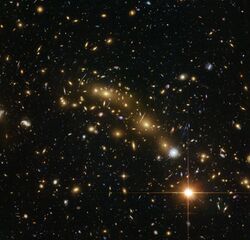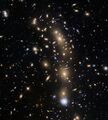Astronomy:MACS J0416.1-2403
| MACS J0416.1–2403 | |
|---|---|
 Galaxy cluster MCS J0416.1–2403 imaged by the Hubble Space Telescope Credit: ESA/Hubble, NASA, HST Frontier Fields | |
| Observation data (Epoch J2000.0[1]) | |
| Constellation(s) | Eridanus |
| Right ascension | 04h 16m 09.9s[1] |
| Declination | −24° 03′ 58″[1] |
| Redshift | 0.420000[1] |
| Other designations | |
| MACS J0416.1-2403,[1] MACS J0416-2403, MACS 0416.1-2403, MACS 0416-2403, 1RXS J041609.9-240358[1] | |
MACS J0416.1-2403 or MACS0416 abbreviated, is a cluster of galaxies at a redshift of z=0.397 with a mass 160 trillion times the mass of the Sun inside 200 kpc (650 kly). Its mass extends out to a radius of 950 kpc (3,100 kly) and was measured as 1.15 × 1015 solar masses.[2] The system was discovered[3] in images taken by the Hubble Space Telescope during the Massive Cluster Survey, MACS.[4] This cluster causes gravitational lensing of distant galaxies producing multiple images.[5][6] Based on the distribution of the multiple image copies, scientists have been able to deduce and map the distribution of dark matter.[7][8] The images, released in 2014,[9] were used in the Cluster Lensing And Supernova survey with Hubble (CLASH) to help scientists peer back in time at the early Universe and to discover the distribution of dark matter.[10]
Gallery
MACS J0416.1-2403 contains a significant amount of dark matter, which leaves a detectable imprint in visible light by distorting the images of background galaxies.[11]
Very massive cluster of galaxies, MACS0416.1-2403, located roughly 4 billion light-years away.[12]
Galaxy cluster MACS J0416.1–2403 is one of six being studied by the Hubble Frontier Fields programme.[13]
References
- ↑ 1.0 1.1 1.2 1.3 1.4 1.5 "Object No. 1 - MACS J0416.1-2403". NASA/IPAC Extragalactic Database. https://ned.ipac.caltech.edu/cgi-bin/objsearch?objname=MACS+J0416.1-2403&extend=no&hconst=73&omegam=0.27&omegav=0.73&corr_z=1&out_csys=Equatorial&out_equinox=J2000.0&obj_sort=RA+or+Longitude&of=pre_text&zv_breaker=30000.0&list_limit=5&img_stamp=YES.
- ↑ Jauzac, Mathilde et al. (23 June 2014). "Hubble Frontier Fields: The Geometry and Dynamics of the Massive Galaxy Cluster Merger MACSJ0416.1-2403". Monthly Notices of the Royal Astronomical Society 446 (4): 4132–4147. doi:10.1093/mnras/stu2425. Bibcode: 2015MNRAS.446.4132J.
- ↑ Mann, Andrew; Harald Ebeling (March 2012). "X-ray-optical classification of cluster mergers and the evolution of the cluster merger fraction". Monthly Notices of the Royal Astronomical Society 420 (3): 2120–2138. doi:10.1111/j.1365-2966.2011.20170.x. Bibcode: 2012MNRAS.420.2120M.
- ↑ Ebeling, Harald; Alastair Edge; J. Patrick Henry (June 2001). "MACS: A Quest for the Most Massive Galaxy Clusters in the Universe". The Astrophysical Journal 553 (2): 668–676. doi:10.1086/320958. Bibcode: 2001ApJ...553..668E.
- ↑ Diego, Jose M. (4 June 2014). "Free Form Lensing Implications for the Collision of Dark Matter and Gas in the Frontier Fields Cluster MACSJ0416.1-2403". Monthly Notices of the Royal Astronomical Society 447 (4): 3130–3149. doi:10.1093/mnras/stu2660. Bibcode: 2015MNRAS.447.3130D.
- ↑ "New mass map of a distant galaxy cluster is the most precise yet". 24 July 2014. http://phys.org/news/2014-07-mass-distant-galaxy-cluster-precise.html.
- ↑ Cho, Adrian (2017). "Scientists unveil the most detailed map of dark matter to date". Science. doi:10.1126/science.aal0847. https://www.science.org/content/article/scientists-unveil-most-detailed-map-dark-matter-date.
- ↑ Natarajan, Priyamvada; Chadayammuri, Urmila; Jauzac, Mathilde; Richard, Johan; Kneib, Jean-Paul; Ebeling, Harald; Jiang, Fangzhou; Bosch, Frank van den et al. (2017). "Mapping substructure in the HST Frontier Fields cluster lenses and in cosmological simulations". Monthly Notices of the Royal Astronomical Society 468 (2): 1962–1980. doi:10.1093/mnras/stw3385. Bibcode: 2017MNRAS.468.1962N. https://academic.oup.com/mnras/mnras/article/2970349/Mapping.
- ↑ "New mass map of a distant galaxy cluster is the most precise yet". 24 July 2014. https://esahubble.org/news/heic1416/.
- ↑ "Cluster Lensing And Supernova survey with Hubble (CLASH)". 23 June 2017. https://archive.stsci.edu/prepds/clash/.
- ↑ "A cosmic kaleidoscope". http://www.spacetelescope.org/images/potw1612a/.
- ↑ "Faint Compact Galaxy in the Early Universe". http://www.spacetelescope.org/images/opo1545a/.
- ↑ "Hubble Frontier Fields view of MACSJ0416.1–2403". http://www.spacetelescope.org/images/heic1523a/.
 |




